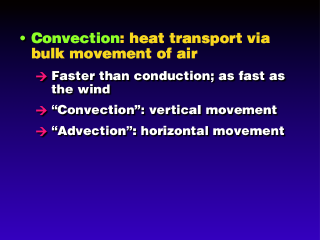 The wind is considered the primary transport mechanaism for convection.
The molecules carry the actual heat energy, but instead of waiting for the energy
to transfer from one molecule to the next as in conduction, the molecules themselves
are moved from one point to another.
The wind is considered the primary transport mechanaism for convection.
The molecules carry the actual heat energy, but instead of waiting for the energy
to transfer from one molecule to the next as in conduction, the molecules themselves
are moved from one point to another.
It is possible for "cold"
air molecules to move as well as "hot" ones, so it can appear that
"coldness" can be transported, which violates our understanding that
heat can only be transported from regions of high heat content to ones of lower
heat content. However, note that as cool air travels someplace, air in the new
location is displaced and air must fill the void left by the moving cool air.
Warmer air will fill that space (probably from the new location of the cool
air), so there is still hot-to-cold heat transport.
While this general form of heat transfer
is called convection, the term "convection" refers to vertical
winds (travelling perpendicular to the ground), and "advection"
refers to horizontal winds (parallel to the ground).
When heat is transferred to/from
the air by conduction, the temperature of the air changes (a loss of heat causes
temperature to decrease; a gain of heat causes temperature to increase. This
is referred to as a "sensible" heat transfer, because we "sense"
the heat transfer by the change in temperature.
Convection also accomplishes sensible
heat transfer; this is how the air above the Earth's surface (above the thin
layer of air that gets heated by conduction) gets heated. A thermal,
which is a bubble of warm, buoyant air, rises upward from the superheated air
that was formed by heat conduction from the ground to the air in contact with
the ground. The thermal convects heat upward. As the thermal rises, it loses
temperature (not by a sensible heat loss, however; it's due to adiabatic
expansion). At some point, its temperature may be low enough that water
vapor starts to condense out and form a cloud. This releases latent
heat into the air aloft. This latent heat was first absorbed into the air
when water evaporated into the air at the Earth's surface. So, this convection
accomplishes both a sensible heat transfer (heat moving upward with the
thermal) and a latent heat transfer (latent heat absorbed from the ground,
convected with the water vapor upward, then released when the vapor condensed).



 The wind is considered the primary transport mechanaism for convection.
The molecules carry the actual heat energy, but instead of waiting for the energy
to transfer from one molecule to the next as in conduction, the molecules themselves
are moved from one point to another.
The wind is considered the primary transport mechanaism for convection.
The molecules carry the actual heat energy, but instead of waiting for the energy
to transfer from one molecule to the next as in conduction, the molecules themselves
are moved from one point to another.